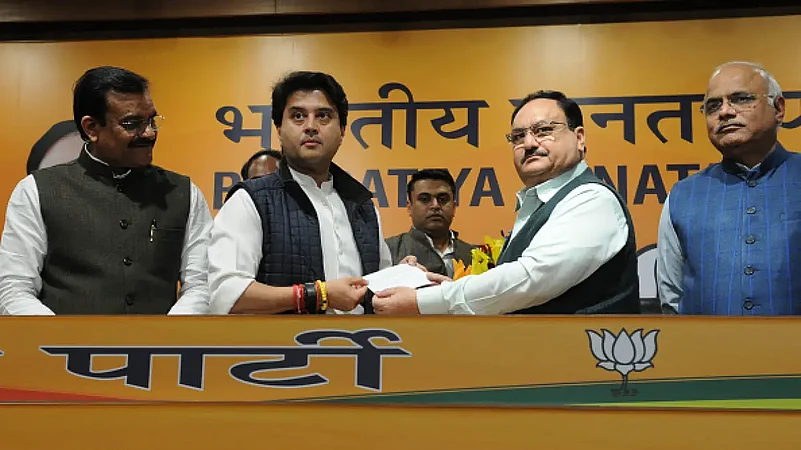Indian political parties have recorded defections, desertions and splits in their ranks across several phases since Independence, with different reasons propelling political instability in each of these. Earlier, a weak Centre and a fragmented polity in states led to defections as politicians switched camps in order to form a majority government. The trend seems to have marked a curious reversal in the last eight years.
The presence of a mighty political party with a mammoth majority at the Centre and strong governments in a large number of states now ensure these splits and dethroning of elected governments. The Bharatiya Janata Party’s (BJP) engineering has been ably complemented by a consistently weakening Congress, and its failure to hold on to its party cadres, as these two parties have become the major actors of the defection drama in the recent years.
Advertisement
The fall of several state governments in recent years ranging from Madhya Pradesh, Manipur, Goa, Arunachal Pradesh, Karnataka and, most recently, Maharashtra were caused by the defections of MLAs. In almost all these cases, the BJP seemed to have precipitated the crisis and ended up with forming a new government. The Congress government of Madhya Pradesh was dethroned in March 2020 when the Covid-19 pandemic had already arrived.
Defections are no longer a symptom of fractured polity as the moment a stable government faces some inner dissent, the BJP quickly senses an opportunity in it. It was witnessed during the ongoing tenure of the Ashok Gehlot government in Rajasthan before the crisis was averted.
Advertisement
Congress ranks getting depleted
The Congress has seen the maximum and the most high-profile exits in recent years. The party’s strong face in Assam Himanta Biswa Sarma joined the BJP in 2015 and eventually became the Chief Minister in 2021. Manipur leader N Biren Singh joined the BJP due to differences with his Congress party and was later made the CM.
The Congress also saw the sitting Arunachal Pradesh CM Pema Khandu leaving the party and eventually joining the BJP. Former Maharashtra CM Narayan Rane joined the BJP in 2019, and is now a minister in the Narendra Modi government. Similarly, the party's major face in Madhya Pradesh Jyotiraditya Scindia is now a Union minister.
This year, senior leader and former Cabinet minister Kapil Sibal stunned everyone by leaving the party and filing his Rajya Sabha nomination from the Samajwadi Party. Among those big leaders who recently left the party include former Punjab Chief Minister Captain Amarinder Singh, former Punjab party president Sunil Jakhar who joined the BJP, former Union minister Ashwani Kumar, and party’s strongmen in UP Jitin Prasada and RPN Singh, both of whom joined the BJP. Prasada is now a minister in the Yogi Adityanath government.
The Uttarakhand drama
The Congress versus BJP battle perhaps reached its peak during the 2017 assembly elections in Uttarakhand. At that time, the Congress still had governments in several states, including Uttarakhand, and was expected to give a tough contest to the BJP. But the election saw both the parties trying to poach each other’s members.
Advertisement
This election saw unprecedented defections and crossovers in all but 15-20 of the state’s 70 seats. The BJP gave tickets to 13 Congress rebels, three of them hours after they joined the party. The Congress obliged seven BJP rebels. Such were the open defections that even the Rashtriya Swayamsevak Sangh (RSS) turned against the BJP. In the Gangotri constituency, a veteran RSS swayamsevak and one of the oldest Jan Sangh members in Uttarkashi, Surat Ram Nautiyal, contested against the BJP candidate Gopal Singh Rawat, who had been with the Congress and the Bahujan Samaj Party (BSP) earlier.
This nearly mirrored the situation earlier in Goa, where RSS leaders had turned against the BJP.
Advertisement
For well over a decade after its formation, Uttarakhand saw massive infighting in the ranks of both the Congress and the BJP. The state saw regular political coups with eight CMs in its first 16 years, and several of them changing their camps, including Congress stalwart Narayan Datt Tiwari who later joined the BJP. The state’s first CM, the BJP’s Nityanand Swami, also lost his post due to internal dissent. The party’s first seven years of rule saw five CMs, while the Congress saw three CMs in its 10 years in power.
Opportunistic alliances
Two major factors that have seriously damaged the Indian polity are opportunistic alliances and political defections. Both are interrelated and often appear together, most recently after Eknath Shinde defected with Shiv Sena MLAs to dethrone Uddhav Thackeray before he joined hands with the BJP to form the government in Maharashtra.
Advertisement
In July 2017, Bihar Chief Minister Nitish Kumar stunned political analysts twice in a week. He first deserted his ally Rashtriya Janata Dal (RJD) and, having lost the majority, resigned as the chief minister. Soon after, he joined hands with the BJP, a party he had been opposing for last several years. He had been an alliance partner with the BJP-led NDA for long before he quit it in 2013 opposing Narendra Modi as the prime minister candidate. Four years later, he returned to the alliance in order to secure his Bihar throne, with Modi now as the PM.
The country seems to be in an era of defections with the BJP being the biggest gainer, and the Congress the biggest loser. A 2021 report by Association of Democratic Reforms (ADR) says that of the total MLAs who left their parties during elections and contested from another party between 2016 and 2020, as many as 170 (42 per cent) left the Congress. During the same period, 182 (44.9 per cent) of the 405 re-contesting MLAs who switched political parties joined the BJP. Significantly, as many as 433 MLAs and MPs changed their parties and contested the elections. Of these, 225 won, indicating that voters had little difficulty in electing a turncoat candidate.




















